α-Al2O3 Functionalized with Lithium Ions Especially Useful as Inert Catalyst Bed Supports
Abstract
:1. Introduction
- -
- Heat output;
- -
- Type of fuel;
- -
- Stability of operation;
- -
- Emission of components harmful to the environment;
- -
- Material of the burner;
- -
- Heat transfer mechanism.
2. Results and Discussion
2.1. Li/Al2O3 Material Characterization
2.2. Al2O3 Doping Studies
2.3. Experimental Firing Tests
3. Materials and Methods
- Catalytic Activity Enhancement: Lithium ions can be introduced into aluminum oxide to modify its surface properties, which improves its affinity for reactants and enhances catalytic activity. These modifications can lead to more effective catalytic cycles in combustion reactions.
- Stabilization of Active Sites: Lithium ions can stabilize active sites on aluminum oxide, facilitating better adsorption of reaction intermediates. This stabilization can optimize the overall catalytic performance during combustion processes.
- Influence on Reaction Kinetics: Lithium ions may alter the kinetics of the reactions taking place over aluminum oxide, resulting in improved efficiency of combustion reactions. The presence of lithium can lead to enhanced transformation pathways that are beneficial for catalytic processes.
3.1. Experimental Installation
3.2. The Procedure for the Experimental Tests
4. Conclusions
- -
- Using fuel type F1 with a burner output of 1.5 kW and an air ratio of 1.67, the porous inert media (PIM) with the lithium catalyst reached a maximum temperature 23.2 °C higher than without the catalyst. For fuel types F2 and F3 with air ratios of 1.77 and 1.79, respectively, the PIM with the catalyst achieved temperature increases of 28.2 °C and 51.4 °C, respectively.
- -
- Carbon monoxide (CO) concentrations were consistently higher in the PIM without the lithium catalyst, with the largest difference observed during the combustion of fuel type F1. Nitrogen oxide (NOx) concentrations remained stable and low throughout all experiments.
- -
- The presence of the lithium catalyst shifted the flame position upstream.
- -
- There is a substantial potential of lithium catalysts to improve combustion efficiency and reduce emissions in porous media applications.
- -
- Further investigations are to be made for different positions of the catalyst in regard to the flue gas in order to improve the residence time between the flue gas and the catalytic material for better results in terms of further reducing the content of NOx and CO in the resulting flue gas from the combustion process.
Author Contributions
Funding
Institutional Review Board Statement
Informed Consent Statement
Data Availability Statement
Conflicts of Interest
References
- Wood, S.; Harris, A.T. Porous burners for lean-burn applications. Prog. Energy Combust. Sci. 2008, 34, 667–687. [Google Scholar] [CrossRef]
- Abdul Mujeebu, M.; Abdullah, M.Z.; Abu Bakar, M.Z.; Mohamad, A.A.; Abdullah, M.K. Applications of porous media combustion technology—A review. Appl. Energy 2009, 86, 1365–1375. [Google Scholar] [CrossRef]
- Deraz, N.-A.M.; Salim, H.H.; El-Aal, A.A. The influence of lithium on the hydrogen peroxide decomposition activity of manganese–alumina catalysts. Mater. Lett. 2002, 53, 102–109. [Google Scholar] [CrossRef]
- Mertens, J.H.A.; Prins, R. Influence of pH on the preparation of monometallic rhodium and platinum, and bimetallic Rhodium Platinum Catalysts supported on γ-Alumina. Appl. Catal. 1989, 46, 31–44. [Google Scholar] [CrossRef]
- O’Young, C.L. Effects of alkali-metal promoters (potassium and cesium) on a molybdenum/.gamma.-alumina catalyst. J. Phys. Chem. 1989, 93, 2016–2018. [Google Scholar] [CrossRef]
- Chin, R.L.; Hercules, D.M. The influence of zinc on the surface properties of cobalt-alumina catalysts. J. Catal. 1982, 74, 121–128. [Google Scholar] [CrossRef]
- Hasan, M.H.; Zaki, M.I.; Pasupulety, L.; Kumari, K. Promotion of the hydrogen peroxide decomposition activity of manganese oxide catalysts. Appl. Catal. 1999, 181, 171–179. [Google Scholar] [CrossRef]
- Lewandowski, M.; Sarbak, Z. The effect of lanthanum and zinc ions on the activity of alumina supported nickel–molybdenum catalysts. Appl. Catal. 1998, 173, 87–93. [Google Scholar] [CrossRef]
- Xanthopoulou, G. Oxide catalysts for pyrolysis of diesel fuel made by self-propagating high-temperature synthesis. Part I: Cobalt-modified Mg–Al spinel catalysts. Appl. Catal. 1999, 182, 285–295. [Google Scholar] [CrossRef]
- Calverley, E.M.; Anderson, R.B. Synthesis of higher alcohols over promoted copper catalysts. J. Catal. 1987, 104, 434–440. [Google Scholar] [CrossRef]
- Huang, T.-J.; Lee, K.-C.; Yang, H.-W.; Dow, W.-P. Effect of chromium addition on supported copper catalysts for carbon monoxide oxidation. Appl. Catal. 1998, 174, 199–206. [Google Scholar] [CrossRef]
- Cimino, A.; Jacono, M.L.; Schiavello, M. Effect of zinc, gallium, and germanium ions on the structural and magnetic properties of nickel ions supported on alumina. J. Phys. Chem. 1975, 79, 243–249. [Google Scholar] [CrossRef]
- Gavriilidis, A.; Sinno, B.; Varnia, A. Influence of Loading on Metal Surface Area for Ag/α-Al2O3 Catalysts. J. Catal. 1993, 139, 41. [Google Scholar] [CrossRef]
- Lycourphiotis, A.; Vattis, D.; Karaiskakis, G.; Katsonos, N. Catalytic deactivation of Co-Mo hydrodesulphurization catalysts supported on γ-Al2O3 doped with Li+ ions. J. Less-Common Met. 1982, 86, 137. [Google Scholar] [CrossRef]
- Mulcahy, F.M.; Kozminski, K.D.; Sliko, J.M.; Ciccone, F.; Scierra, S.J.; Eberhard, M.A.; Houalla, M.; Hercules, D.M. Chemisorption of CO2 on alumina-supported catalysts. J. Catal. 1993, 139, 688. [Google Scholar] [CrossRef]
- Nag Nabin, K. A study on the dispersion and catalytic activity of gamma alumina-supported palladium catalysts. Catal. Lett. 1994, 24, 37–46. [Google Scholar]
- Wendt, G.; Fritsch, E.; Deininger, D.; Scholiner, R. Studies on nickel oxide mixed catalysts, V. Propene dimerization on Nio− Al2O3/SiO2 catalysts. React. Kinet. Catal. Lett. 1981, 16, 137–141. [Google Scholar] [CrossRef]
- Desiken, A.N.; Hoang, L.; Oyama, S.T. Structure and dispersion of molybdenum oxide supported on alumina and titania. J. Chem. Soc. Faraday Trans. 1992, 88, 3357–3365. [Google Scholar] [CrossRef]
- Sifontes, Á.B.; Gutierrez, B.; Mónaco, A.; Yanez, A.; Díaz, Y.; Méndez, F.J.; Llovera, L.; Cañizales, E.; Brito, J.L. Preparation of functionalized porous nano-γ-Al2O3 powders employing colophony extract. Biotechnol. Rep. 2014, 4, 21–29. [Google Scholar] [CrossRef]
- Boumaza, A.; Favaro, L.; Lédion, J.; Sattonnay, G.; Brubach, J.B.; Berthet, P.; Huntz, A.M.; Royc, P.; Tot, R.T. Transition alumina phases induced by heat treatment of boehmite: An X-ray diffraction and infrared spectroscopy study. J. Solid State Chem. 2009, 182, 1171–1176. [Google Scholar] [CrossRef]
- Perander, L.M.; Zujovic, Z.D.; Hyland, M.M.; Smith, M.E.; O’Dell, L.A.; Metson, J.B. Short- and long-range order in smelter grade alumina–development of nano and microstructures during the calcination of bayer gibbsite, light metals. Miner. Met. Mater. Soc. 2008, 29–35. [Google Scholar]
- Pecharroman, C.; Sobrados, I.; Iglesias, J.E.; Gonzalez-Carreño, T.; Sanz, J. Thermal evolution of transitional aluminas followed by NMR and IR spectroscopies. J. Phys. Chem. B 1999, 103, 6160–6170. [Google Scholar] [CrossRef]
- Tauster, S.J. Strong metal-support interactions. Chem. Res. 1987, 20, 389. [Google Scholar] [CrossRef]
- Tauster, S.J.; Fung, S.C.; Garten, R.L. Strong metal-support interactions. Group 8 noble metals supported on titanium dioxide. J. Am. Chem. Soc. 1978, 100, 170. [Google Scholar] [CrossRef]
- Criado, J.J.; Macias, B.; Main, C.; Rives, V. Physicochemical characterization of oxide Co-TiO2 and Mn-TiO2 systems. J. Mater. Sci. 1985, 20, 1427–1433. [Google Scholar] [CrossRef]
- Jacono, M.L.O.; Schiavello, M.; De Beer, V.H.J.; Minelli, G. Effect of gallium ions and of preparation methods on the structural properties of cobalt-molybdenum-alumina catalysts. J. Phys. Chem. 1997, 81, 1583–1588. [Google Scholar] [CrossRef]
- Iftekhar, S.; Srivastava, V.; Sillanpä, M. Enrichment of lanthanides in aqueous system by cellulose based silica nanocomposite. Chem. Eng. J. 2017, 320, 151–159. [Google Scholar] [CrossRef]
- Cortina, J.L.; Warshawsky, A. Developments in solid-liquid extraction by solvent-impregnated resins. In Ion Exchage and Solvent Extraction; Marinsky, J.A., Marcus, Y., Eds.; Marcel Dekker Inc.: New York, NY, USA, 1997; pp. 195–293. [Google Scholar]
- Almatis, Global Product Data, Almatis, T-162 Tabular Alumina Balls, GP-RCP/016/R01/0812/SDS154, pp. 1–3. Available online: https://www.almatis.com/en/media/875/download?inline=1 (accessed on 3 January 2025).
- Buriac, O.; Ciopec, M.; Duţeanu, N.; Negrea, A.; Negrea, P.; Grozav, I. Platinum (IV) Recovery from Waste Solutions by Adsorption onto Dibenzo-30-crown-10 Ether Immobilized on Amberlite XAD7 Resin–Factorial Design Analysis. Molecules 2020, 25, 3692. [Google Scholar] [CrossRef]
- Atkins, P.; De Paula, J. Physical Chemistry, 8th ed.; W. H. Freeman and Company: New York, NY, USA, 2006; p. 212. [Google Scholar]
- Ives, D.J.G. Chemical Thermodynamics; University Chemistry. Macdonald Technical and Scientific: London, UK, 1971. [Google Scholar]
- Liu, C.; Huang, Q.; Zheng, K.; Qin, J.; Zhou, D.; Wang, J. Impact of Lithium Salts on the Combustion Characteristics of Electrolyte under Diverse Pressures. Energies 2020, 13, 5373. [Google Scholar] [CrossRef]
- Takata, K.; Morita, M.; Matsuda, Y.; Matsui, K. Cycling Characteristics of Secondary Li Electrode in LiBF4/Mixed Ether Electrolytes. J. Electrochem. Soc. 1985, 132, 126–128. [Google Scholar] [CrossRef]
- Zhang, S.; Xu, K.; Jow, T. A new approach toward improved low temperature performance of Li-ion battery. Electrochem. Commun. 2002, 4, 928–932. [Google Scholar] [CrossRef]
- Chen, W.; Zhang, X.; Wei, Y.; Wang, G.; Ma, J. Enhanced catalytic performance of lithium-promoted alumina catalysts for methanol conversion to hydrocarbons. J. Catal. 2015, 322, 58–68. [Google Scholar]
- Baker, L.D. Effects of Lithium Ion Concentration on the Physical and Chemical Properties of Catalytic Alumina. J. Mater. Chem. 2008, 18, 230–236. [Google Scholar]
- Kong, X. Exploring the role of alkali metal ions in the formation of catalytic active sites on alumina. Appl. Catal. A Gen. 2019, 558, 153–162. [Google Scholar]
- Ge, S. The catalytic combustion of methane over lithium-modified alumina: A new strategy for catalyst development. Fuel Process. Technol. 2012, 95, 27–33. [Google Scholar]
- Seth, S. Influence of Li addition on physicochemical properties of alumina and its catalytic activity. Catal. Commun. 2014, 56, 61–65. [Google Scholar]
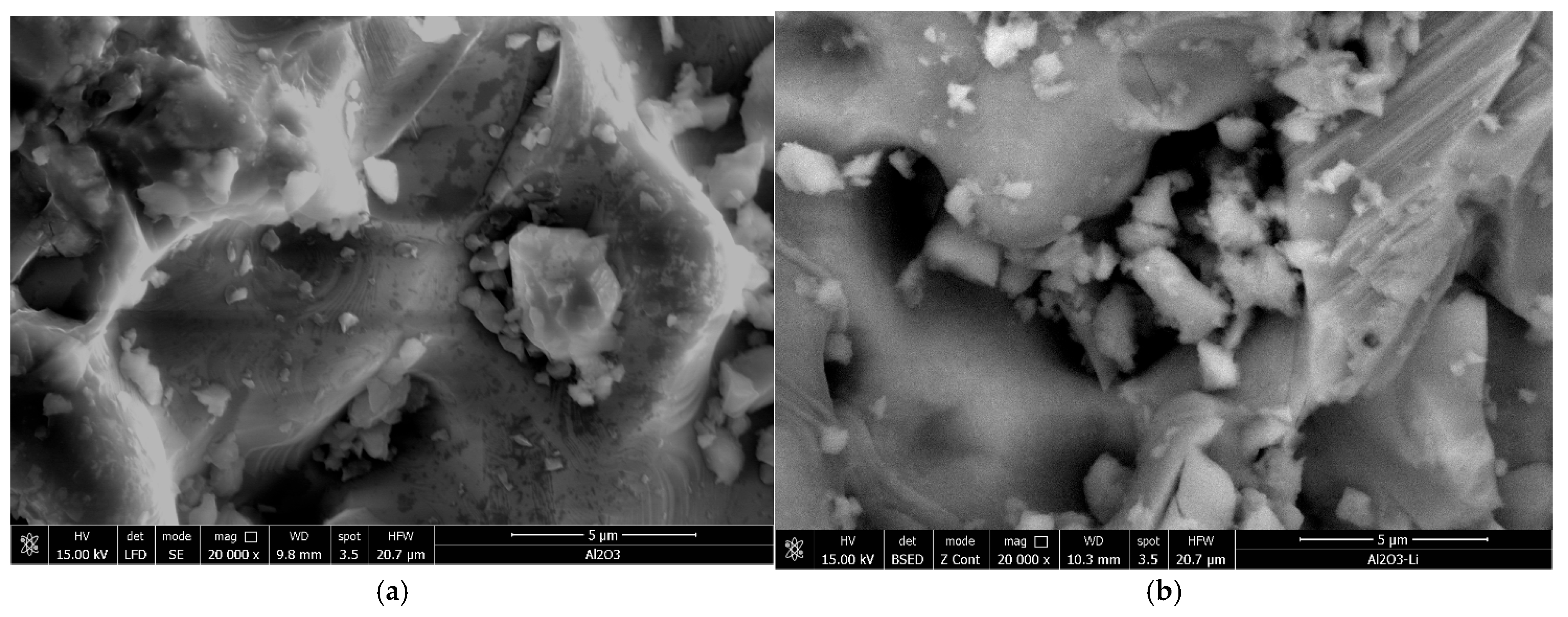
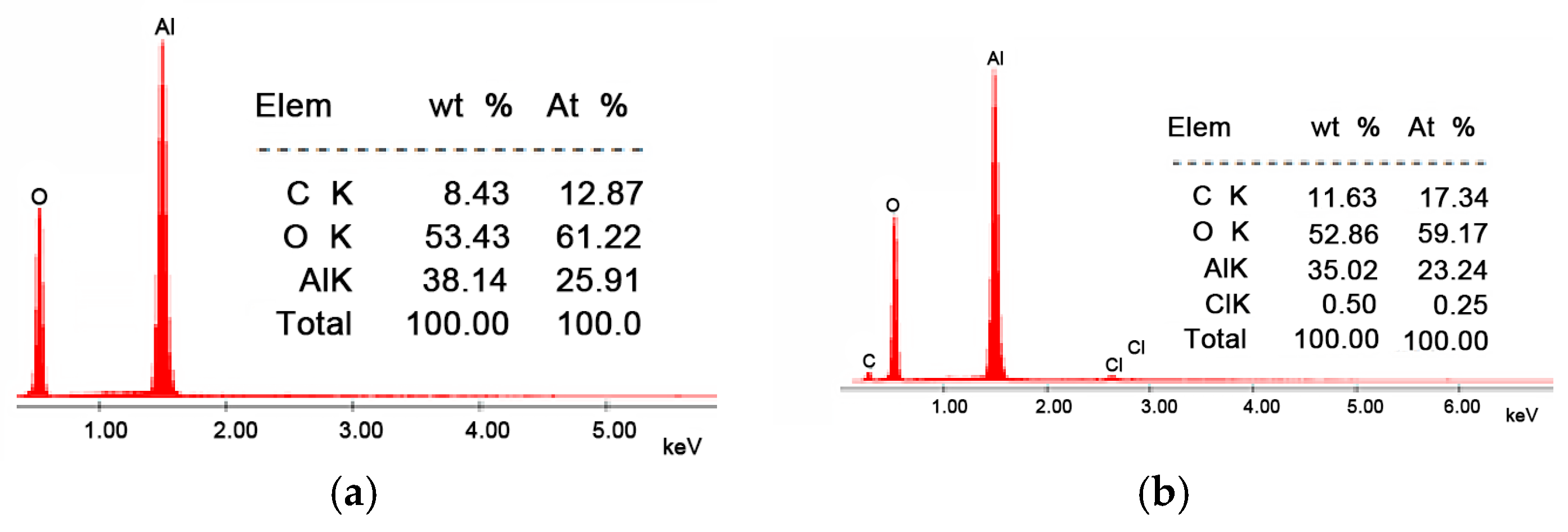
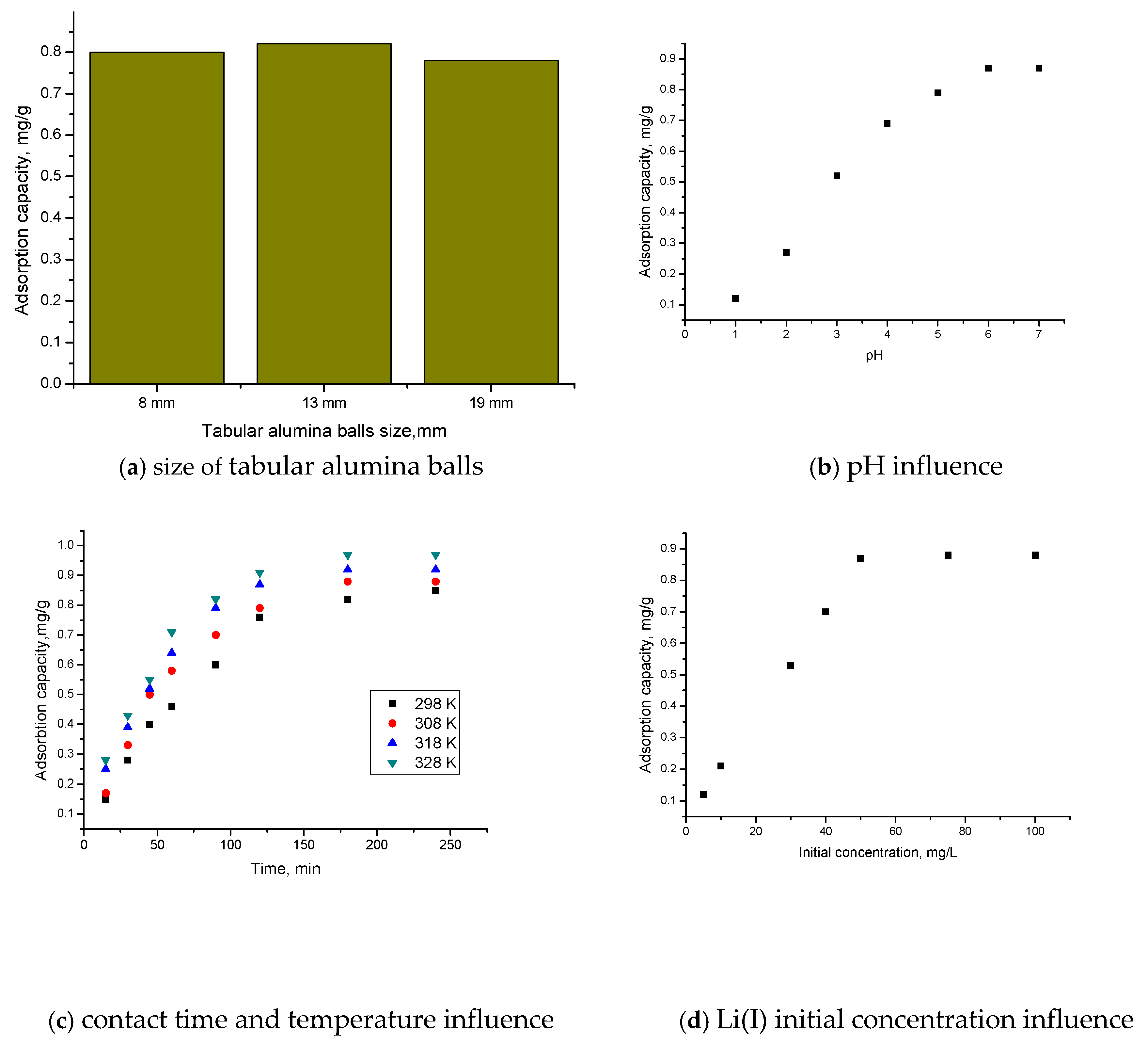
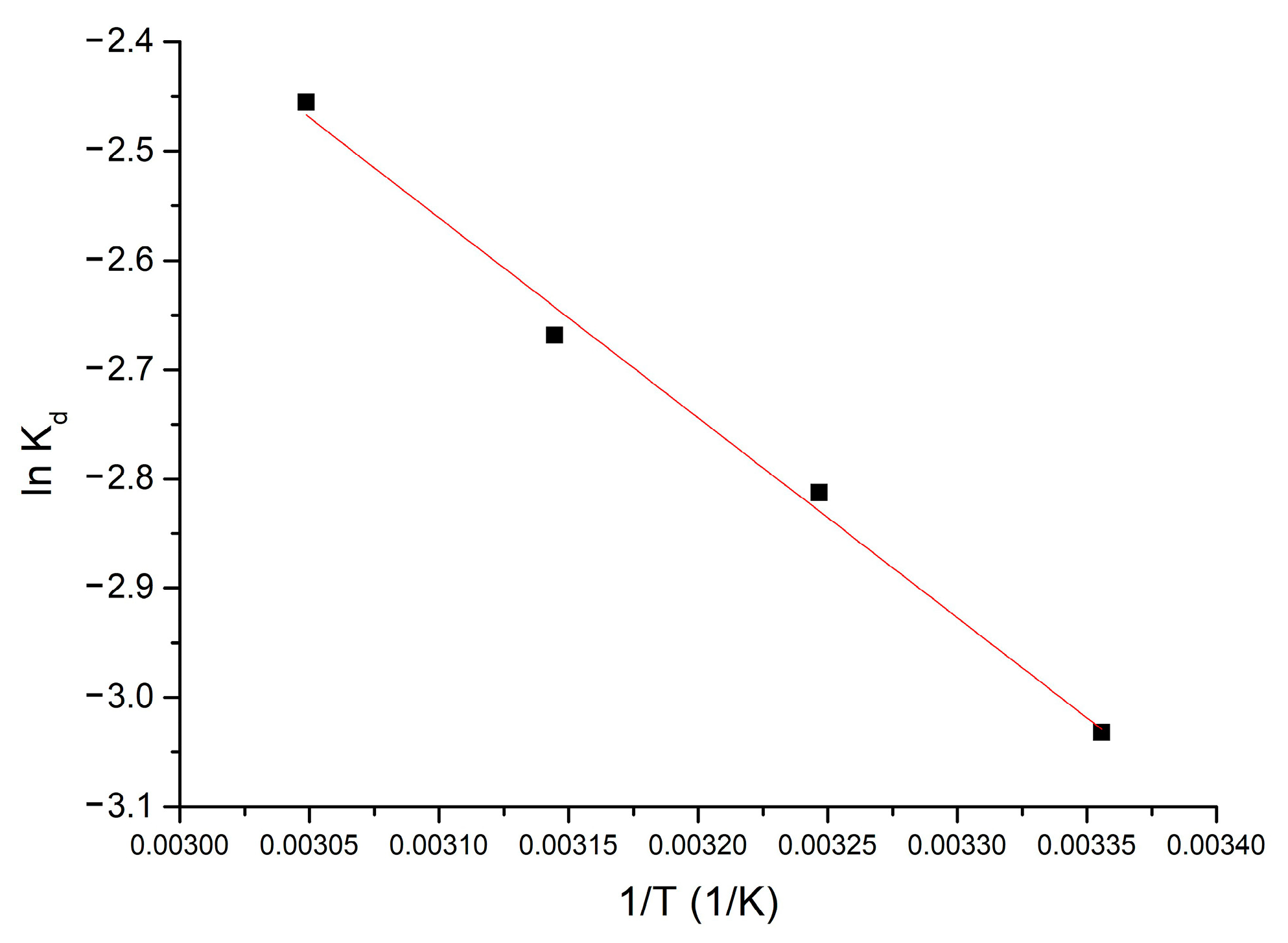

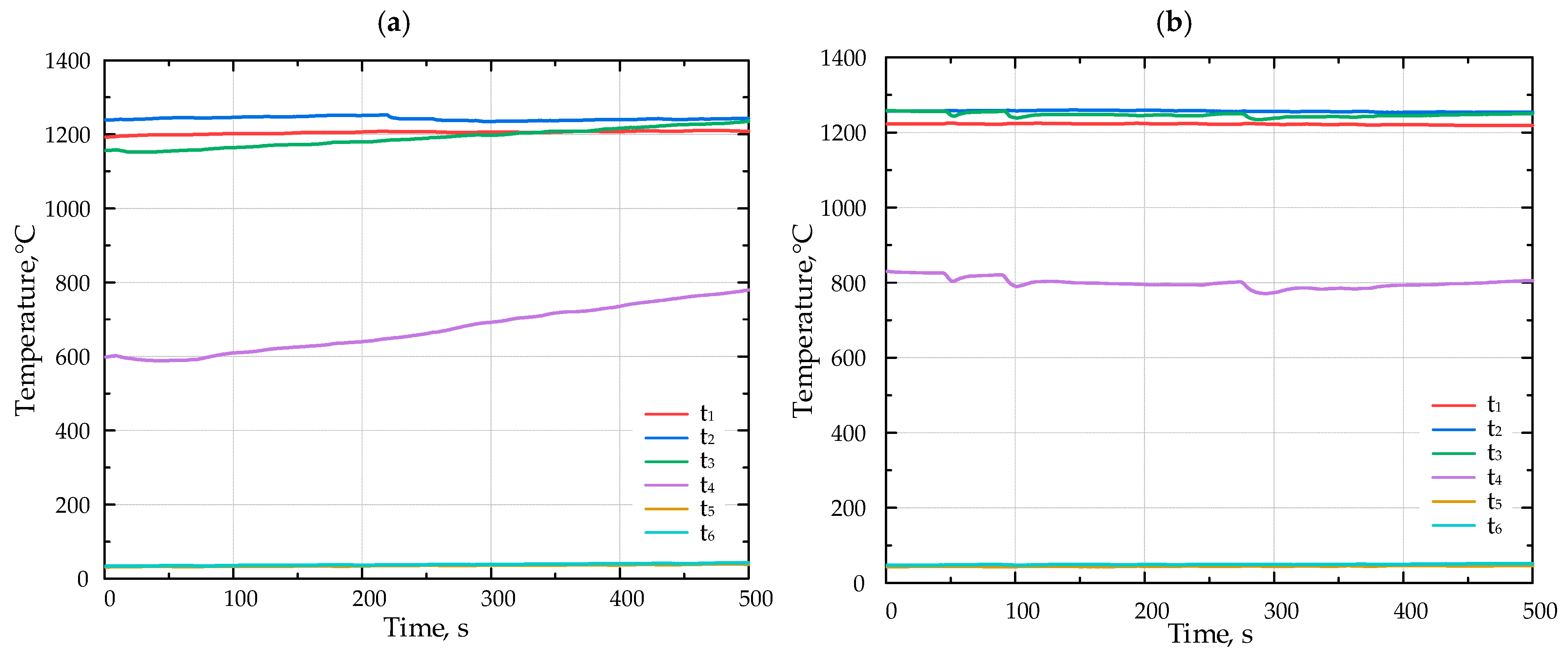
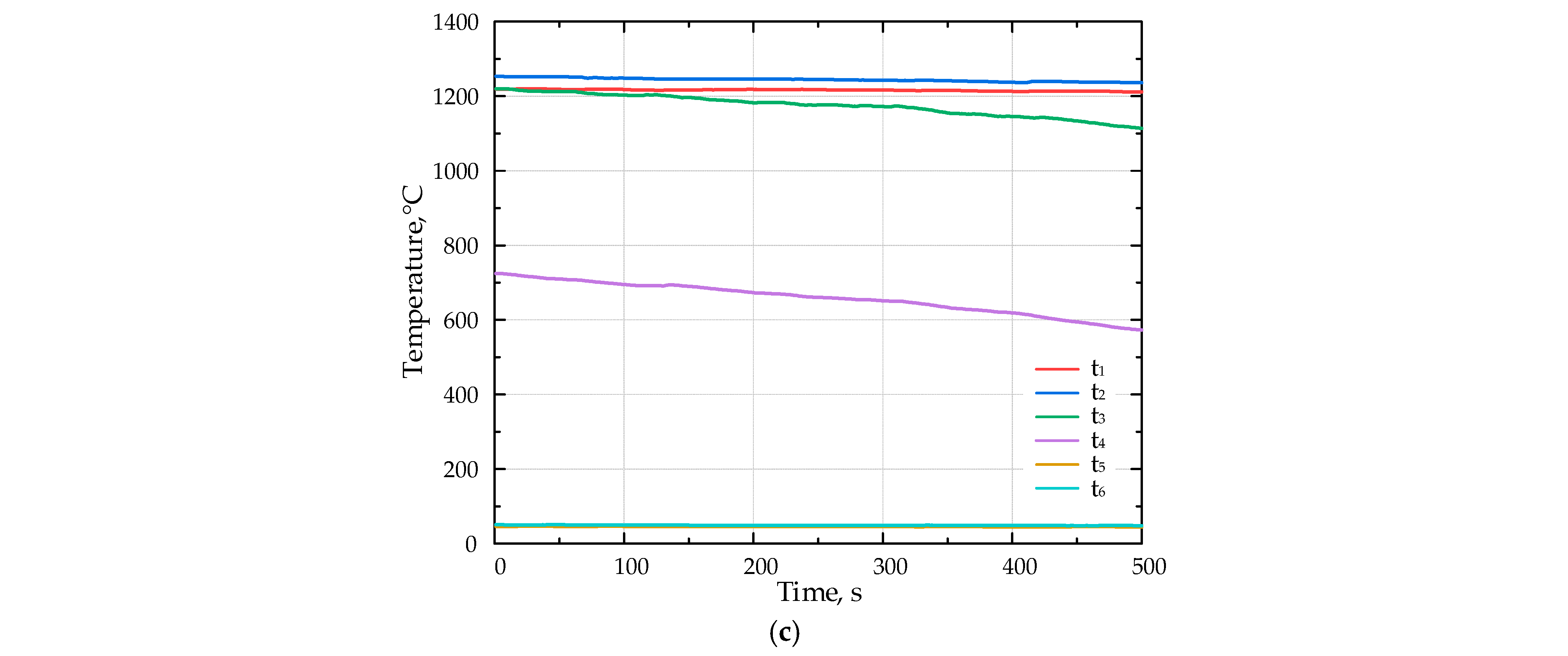

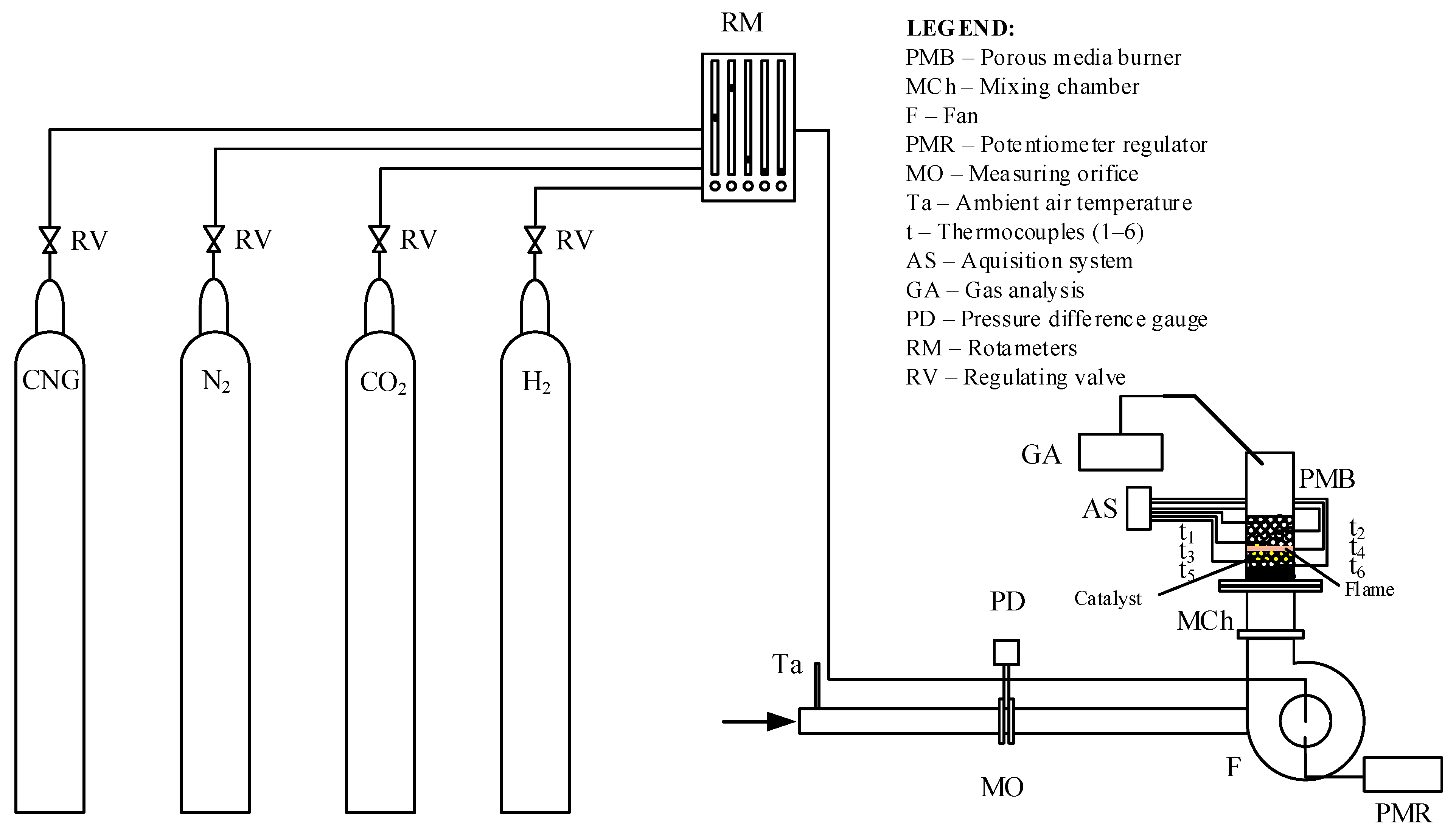
| ΔH° (kJ mol−1) | ΔS° (J mol−1 K−1) | ΔG° (kJ mol−1) | R2 | |||
|---|---|---|---|---|---|---|
| 15.22 | 174.3 | 298 K | 308 K | 318 K | 328K | 0.9907 |
| −51.9 | −53.6 | −55.4 | −57.1 | |||
| Component | CH4 | C2H6 | C3H8 | CO2 | N2 | Hd, MJ/m3 |
|---|---|---|---|---|---|---|
| (% mol) | 93.69 | 1.11 | 0.31 | 0.35 | 4.54 | 34.6 |
| P, kW | Fuel Label | CNG:CO2 | Hd, kJ/m3 | Fuel Composition (% mol) |
|---|---|---|---|---|
| 1.5 | F1 | 80:20 | 27.695 | CH4—74.95 C2H6—0.89 C3H8—0.25 CO2—20.28 N2—3.63 |
| F2 | 70:30 | 24.233 | CH4—65.58 C2H6—0.78 C3H8—0.22 CO2—30.25 N2—3.18 | |
| F3 | 60:40 | 20.771 | CH4—56.21 C2H6—0.67 C3H8—0.19 CO2—40.21 N2—2.72 |
| Fuel Type | Power Output, kW | Air Ratio (λ) | |
|---|---|---|---|
| Without Li-Catalyst | With Li-Catalyst | ||
| F1 | 1.5 | 1.67 | 1.67 |
| F2 | 1.77 | 1.77 | |
| F3 | 1.79 | 1.79 | |
| Fuel Label | Without Li-Catalyst | With Li-Catalyst | Comparation | |||||
|---|---|---|---|---|---|---|---|---|
| tMAX, °C | CO, ppm (vol) | NOx, ppm (vol) | tMAX, °C | CO, ppm (vol) | NOx, ppm (vol) | CO (%) | NOx (%) | |
| F1 | 1229.30 | 71 | 12 | 1252.50 | 1 | 6 | 98.6 | 50.0 |
| F2 | 1231.90 | 18 | 11 | 1260.10 | 5 | 5 | 72.2 | 54.5 |
| F3 | 1202.10 | 15 | 4 | 1253.50 | 5 | 4 | 66.7 | 0.0 |
Disclaimer/Publisher’s Note: The statements, opinions and data contained in all publications are solely those of the individual author(s) and contributor(s) and not of MDPI and/or the editor(s). MDPI and/or the editor(s) disclaim responsibility for any injury to people or property resulting from any ideas, methods, instructions or products referred to in the content. |
© 2025 by the authors. Licensee MDPI, Basel, Switzerland. This article is an open access article distributed under the terms and conditions of the Creative Commons Attribution (CC BY) license (https://creativecommons.org/licenses/by/4.0/).
Share and Cite
Stamenić, M.; Bacoș, T.B.; Milivojević, A.; Adžić, V.; Ciopec, M.; Nemeş, N.S.; Negrea, A.; Cioablă, A.E. α-Al2O3 Functionalized with Lithium Ions Especially Useful as Inert Catalyst Bed Supports. Molecules 2025, 30, 577. https://doi.org/10.3390/molecules30030577
Stamenić M, Bacoș TB, Milivojević A, Adžić V, Ciopec M, Nemeş NS, Negrea A, Cioablă AE. α-Al2O3 Functionalized with Lithium Ions Especially Useful as Inert Catalyst Bed Supports. Molecules. 2025; 30(3):577. https://doi.org/10.3390/molecules30030577
Chicago/Turabian StyleStamenić, Mirjana, Timotei Bogdan Bacoș, Aleksandar Milivojević, Vuk Adžić, Mihaela Ciopec, Nicoleta Sorina Nemeş, Adina Negrea, and Adrian Eugen Cioablă. 2025. "α-Al2O3 Functionalized with Lithium Ions Especially Useful as Inert Catalyst Bed Supports" Molecules 30, no. 3: 577. https://doi.org/10.3390/molecules30030577
APA StyleStamenić, M., Bacoș, T. B., Milivojević, A., Adžić, V., Ciopec, M., Nemeş, N. S., Negrea, A., & Cioablă, A. E. (2025). α-Al2O3 Functionalized with Lithium Ions Especially Useful as Inert Catalyst Bed Supports. Molecules, 30(3), 577. https://doi.org/10.3390/molecules30030577






